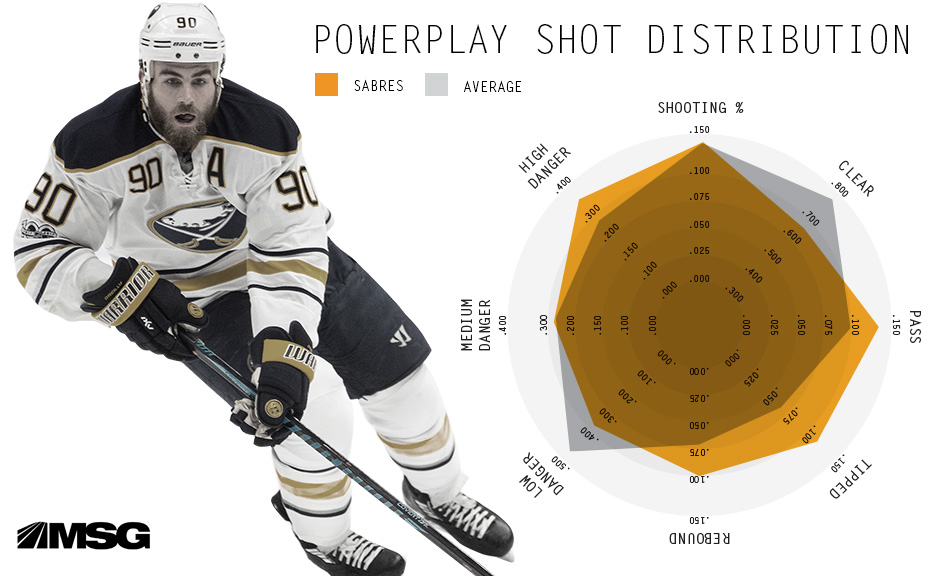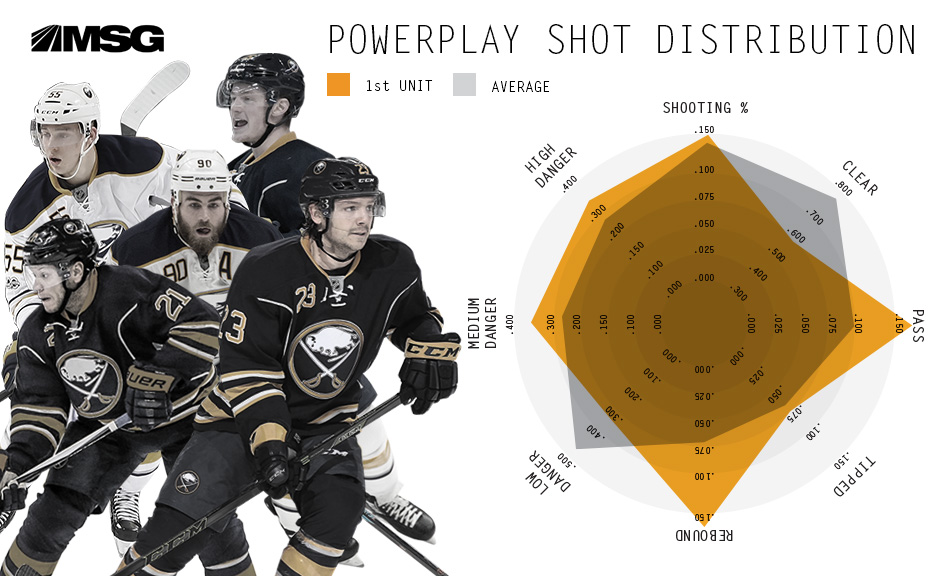By Chris Boyle
Follow @ChrisBoyle33
The Buffalo Sabres are on the perimeter of the playoff race, only four points out with 20 games to go as I write this.
This is a pretty remarkable achievement considering they played a quarter of the season without Jack Eichel and have continually struggled to maintain positive possession numbers. Fortunately, there is a cheat code for poor possession numbers that can temporarily bypass the process. Elite special teams in the form of an overwhelming power-play.
The Sabres trail the Maple Leafs by only one percentage point for the best power-play in the NHL and this success is built around a five-man unit that is extremely efficient at offensive deception. They rarely remain static and constantly shift the defensive box. This opens up ample passing lanes for high percentage opportunities. This is evident in their movement data.

The Sabres consistently create pre-shot movement and are less reliant on clear-sighted looks (65%) from low leverage areas on the ice (37%). This type of movement has allowed them to succeed even though they are only delivering league average shooting results. This is a strong sign that their success is sustainable.
The Sabres success is predicated on versatile forwards who are proficient in all aspects of offensive movement and highlights their most dangerous unit they send out with the man advantage. The four forward, one defenseman unit composed of Eichel, Sam Reinhart, Kyle Okposo, Ryan O’Reilly and Rasmus Ristolainen.

This unit is the Sabres most successful. When they are on the ice, the Sabres are able to dominate the slot line and home-plate area. Almost 35% of their registered shots are either the result of a pass or a rebound opportunity.
The Sabres’ power-play is similar to the recent NBA model of filling the floor with interchangeable parts. Players that aren’t slotted into traditional roles (big point shot, puck distributor, net-front presence and trigger-man), but have multi-faceted skill sets. When forwards can rotate through the offensive zone without a drop in efficiency, they can create less predictable outcomes.
While most power plays pivot from their point men, the Sabres have a ton of success pivoting from the half wall. The Sabres deploy four forwards: Eichel, Reinhart, Okposo and O’Reilly, all of whom are very strong passers. All four have the vision and patience to manipulate passing lanes and find their teammates in open space.
We can see this vision at work. Eichel from the half wall spots the passing lane opened up by O’Reilly’s pick. Okposo also identifies this and quickly fills it. This draws a defender out of position and cascades into another passing lane opening, which Reinhart fills, and Okposo quickly finds.
This type of offensive movement makes it impossible for a goaltender to gain proper visual attachment. The speed with which the puck is moving laterally forces Craig Anderson to constantly swivel his head and re-engage his eyes multiple times and places him in a situation where he is guessing at possible scenarios. This is exactly the type of play design that leads to high-quality chances.
The Sabres have completed 39 slot line passes. Twelve more than an average power-play, a significant number when the expected finishing rate is one in three. Eichel has been responsible for 10, Okposo nine and Reinhart has completed eight. The Sabres take almost 15% of their power-play shots under these circumstances and it is a key reason why their unit has been so dominant in 2016-17.
The also have good size. Every forward is above 6-feet tall and capable of layering in front of the goaltender, compromising their sight lines and deflecting pucks and positioning themselves for high percentage rebounds.
This versatility limits the Sabres’ reliance on low danger area point shots which make up only 37% of their shots (league average 46%) and increases their frequency of tipping pucks and follow up rebound chances in the high danger area (36% vs league average 27%). While Ristolainen possesses a strong shot, teams aren’t able to funnel towards him and take it away because he has multiple pivot points.
The Sabres still seem to lack the depth to compete at a playoff level during 5-on-5 play, but because they can overload the talent they do have on their first power-play unit, they have been able to hang around a playoff spot.
The future foundation is clearly visible and bodes well for the Sabres.
